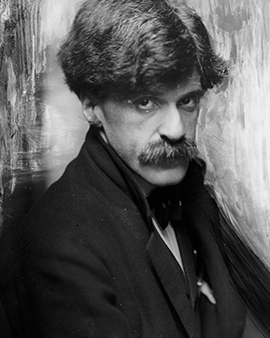Shortly before the end of the American Civil War in January 1864, Alfred Stieglitz saw the light of day as the son of a German-Jewish immigrant family in Hoboken, New Jersey. It was important to his parents that their children receive an adequate education. Consequently, the family clan moved from the East Coast of the USA back to Germany in 1881. The following year, Alfred Stieglitz attended the Technical University in Berlin. It was during this time that he first came into contact with photography. It was not yet foreseeable that he would one day become one of the most important photographers of his time. Initially, the young Stieglitz studied mechanical engineering. At the same time, he discovered a fascination for photography. Alfred became a self-taught photographer and could not get enough of the medium.
1882 was it so far, Stieglitz bought his first camera. Initially, he photographed mainly the German countryside. Quickly the general public recognized his talent and Stieglitz published articles and photographs in the British magazine Amateur Photographer. After the death of his sister, Alfred was drawn back to America in 1890. Shortly thereafter, he became an integral representative of pictorialism. His goal was not just to make a photograph, but to establish each selected chart, as a full-fledged means of artistic expression. He always focused on a special section when choosing his subjects. In his actions, the extraordinary photographer also developed a preference for night and fog scenes. For him, it was of utmost importance to use photographic means to create an image effect similar to a painting. In his depictions, the pictorialist showed landscapes, idyllic scenes as well as people, portraits and nudes romantically placed in the foreground. Alfred Stieglitz not only had a good eye, but also possessed the flair to leave unique impressions for posterity.
Eventually, the photographer matured into a household name. Almost single-handedly, he popularized the medium of photography. Thanks to his expertise, Stieglitz became owner of the fledgling Photochrome Engraving Company and co-publisher of The American Amateur Photographer. It was a smart move, as these pioneering steps solidified Stieglitz's position in the world of photography. Together with his friend Edward Steichen, the visionary opened an avant-garde art gallery on Fifth Avenue in New York in 1905. In the exhibition rooms of Gallery 291, photographic works, African art, and works by European modernist artists could be admired for the first time in the United States. Suddenly, Stieglitz not only advanced to gallery owner, but also became a key figure in photography and art history. In the summer of 1946, Alfred Stieglitz suffered a fatal stroke. What remains are photographs that still trigger recognition and enthusiasm among viewers today.
×





.jpg)
.jpg)
.jpg)
.jpg)
.jpg)
.jpg)
.jpg)
.jpg)
.jpg)
.jpg)
.jpg)
.jpg)
.jpg)
.jpg)
.jpg)
.jpg)
.jpg)
.jpg)
.jpg)
.jpg)
.jpg)
.jpg)
.jpg)
.jpg)
.jpg)
.jpg)
.jpg)
.jpg)
_1933_(gelatin_silver_photo)_-_(MeisterDrucke-1400056).jpg)
_1933_(gelatin_silver_photo)_-_(MeisterDrucke-1400056).jpg)
.jpg)
.jpg)
.jpg)
.jpg)
.jpg)
.jpg)
.jpg)
.jpg)
.jpg)
.jpg)
.jpg)
.jpg)
.jpg)
.jpg)
.jpg)
.jpg)
.jpg)
.jpg)
.jpg)
.jpg)
.jpg)
.jpg)
.jpg)
.jpg)
.jpg)
.jpg)
_-_(MeisterDrucke-1416399).jpg)
_-_(MeisterDrucke-1416399).jpg)
.jpg)
.jpg)
.jpg)
.jpg)
.jpg)
.jpg)
.jpg)
.jpg)
.jpg)
.jpg)
.jpg)
.jpg)
.jpg)
.jpg)
.jpg)
.jpg)
_-_(MeisterDrucke-1416006).jpg)
_-_(MeisterDrucke-1416006).jpg)
.jpg)
.jpg)
.jpg)
.jpg)
.jpg)
.jpg)
_-_(MeisterDrucke-1288131).jpg)
_-_(MeisterDrucke-1288131).jpg)
.jpg)
.jpg)
.jpg)
.jpg)
.jpg)
.jpg)
.jpg)
.jpg)
.jpg)
.jpg)
.jpg)
.jpg)
.jpg)
.jpg)
.jpg)
.jpg)
.jpg)
.jpg)
_-_(MeisterDrucke-1301921).jpg)
_-_(MeisterDrucke-1301921).jpg)
.jpg)
.jpg)
.jpg)
.jpg)
.jpg)
.jpg)
.jpg)
.jpg)
.jpg)
.jpg)
.jpg)
.jpg)
.jpg)
.jpg)
.jpg)
.jpg)
.jpg)
.jpg)
_-_(MeisterDrucke-1349467).jpg)
_-_(MeisterDrucke-1349467).jpg)
.jpg)
.jpg)
.jpg)
.jpg)
.jpg)
.jpg)
.jpg)
.jpg)
.jpg)
.jpg)
.jpg)
.jpg)
.jpg)
.jpg)
.jpg)
.jpg)
.jpg)
.jpg)
_-_(MeisterDrucke-1284965).jpg)
_-_(MeisterDrucke-1284965).jpg)
.jpg)
.jpg)
.jpg)
.jpg)
.jpg)
.jpg)
.jpg)
.jpg)
.jpg)
.jpg)
.jpg)
.jpg)
.jpg)
.jpg)
.jpg)
.jpg)
.jpg)
.jpg)
.jpg)
.jpg)
.jpg)
.jpg)
_-_(MeisterDrucke-1286854).jpg)
_-_(MeisterDrucke-1286854).jpg)
.jpg)
.jpg)
.jpg)
.jpg)
.jpg)
.jpg)
.jpg)
.jpg)
.jpg)
.jpg)
.jpg)
.jpg)
.jpg)
.jpg)
.jpg)
.jpg)
.jpg)
.jpg)
.jpg)
.jpg)
.jpg)
.jpg)
.jpg)
.jpg)
.jpg)
.jpg)
.jpg)
.jpg)
.jpg)
.jpg)
.jpg)
.jpg)






